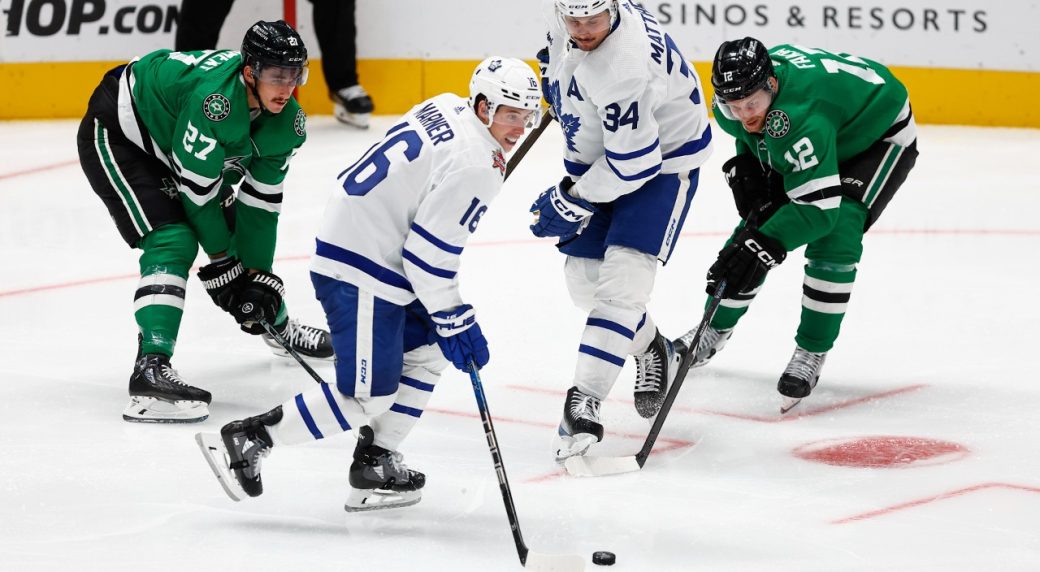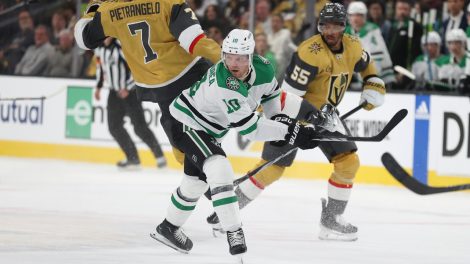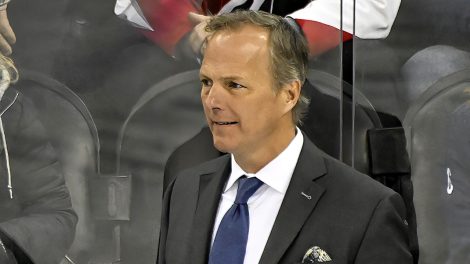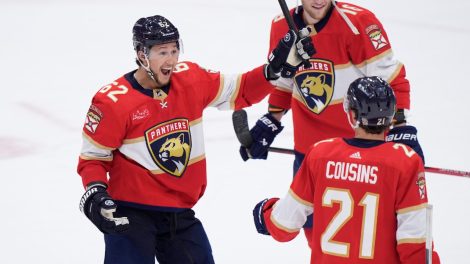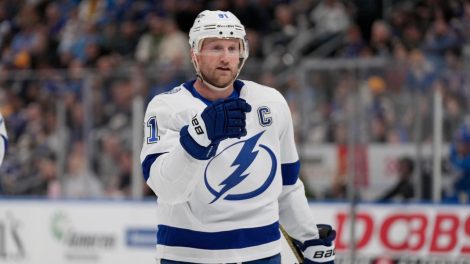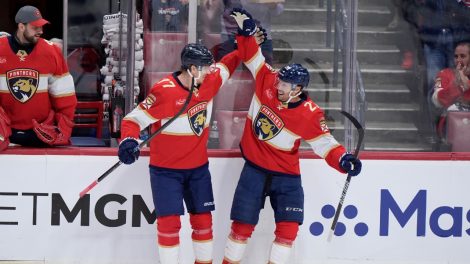When it comes to NHL coaches deploying their best players, “How much is too much” is one of the biggest questions they have to answer. If you lose a game with an elite game-breaker on your bench with gas in the tank, it’s a missed opportunity. On the other hand, if you red-line them too often, you’re hurting both the player and the players being denied more opportunity.
I wanted to spend some time on this question while evaluating the Toronto Maple Leafs, given a few moments over the past couple weeks where their elite players were tired at the end of long power-play shifts, made weak plays with the puck and it put the team on their heels. It became a talking point on the Real Kyper and Bourne podcast, and so I wanted to give it a little more attention.
The argument I heard there — a very reasonable one — is that the top unit of the Leafs eats up way too much of the power play and that they should get off quicker, allowing for the second unit to get some power-play time, too.
One of the modern analytics arguments I’ve heard claims the opposite, saying the best players should play more. In the recently published numbers book “Game of Edges” on the history of the analytics movement, “star players should play more” is the sole item offered for hockey teams to potentially improve using data. While the book does not necessarily profess to do serious hockey analysis, it is simply a more common point made in passing from those who believe in the value of data these days: What if we just played the good players more?
This concept has spread to the discussion of using stars on the power play, and particularly that of the Leafs. These days, the more progressive hockey fan will say that coaches should play the heck out of their top dawgs. The days of PP1 and PP2 seem mostly over, with one power-play unit and some guys who come out to play out the final 25 seconds after a cleared puck. There’s a simple argument: Auston Matthews operating at 70 per cent is more likely to score than, say, Tyler Bertuzzi at 100 per cent.
That’s fine, and I’d agree, if you’re just managing a single crucial moment. But running Matthews out there so much that he’s operating at 70 per cent (and using him at that capacity, so he’s only further burning out his legs) likely hurts his ability to be at 100 per cent again that game, let alone if you do it regularly and expect him to be able to find that gear every game all season.
Once you burn your legs out and the lactic acid starts to build up and your legs get heavy, there’s no guarantee you ever get them back that night. It’s the ability to create special moments that separates a guy like Matthews in a game, so is it worth lowering his ceiling to avoid handing over to Bertuzzi 20 seconds of his power-play time?
These debates are situational, and moment to moment. So while it’s true that in the final seconds of a game you’re chasing you may rather burn out your top guys than play your second unit at 100 per cent, I don’t think you want to do it in any old game in any period in the middle of a season.
With all these arguments in mind, let’s look at the numbers, which show us that compared to other top teams, the Leafs stars don’t actually hog too many of the power-play minutes.
Since we’re really talking about the elite forwards here, and every team uses a 1-3-1 on the power play, below is a look at the five best power-play teams in the NHL this season, and the percentage of their power play time that gets played by their four most-used forwards.
You’ll notice one of these teams — Carolina — is an extreme deployment outlier from the other four (and from the entire top 10, really).
So, with 32 teams and four forwards per team, we’re looking at rankings out of 128 skaters. Below those top-four forwards, we’ll look at the percentage of team power-play time on ice for the fifth forward, as a loose proxy for how much the second unit may get to touch the ice.
1st: Tampa Bay – 30.0%
RANK | NAME | % OF PP TOI |
2 | Kucherov | 84.1 |
6 | Stamkos | 78.0 |
7 | Point | 77.2 |
29 | Paul | 71.6 |
Fifth: Hagel, 26.0%
When Tampa Bay is on the power play, Nikita Kucherov is on the rink over 84 per cent of the time, and I can’t say I blame coach Jon Cooper here. Kuch is a power-play savant.
2nd: Carolina – 28.0%
RANK | NAME | % OF PP TOI |
66 | Aho | 62.7 |
67 | Jarvis | 62.3 |
98 | Bunting | 56.4 |
109 | Svechnikov | 53.4 |
Fifth: Teravainen, 50.9%
This is easily the craziest top-four of any team I could find. No player logs even 63 per cent of their power-play minutes, which means there’s no central cog, yet they’re at 28 per cent on the season. Here’s to unpredictability, I suppose.
3rd: Edmonton – 26.8%
RANK | % OF PP TOI | |
8 | Draisaitl | 76.6 |
9 | Nugent-Hopkins | 76.2 |
11 | McDavid | 76.0 |
22 | Hyman | 72.8 |
Fifth: Kane, 30.8%
Anything less than deploying 29 and 97 for 75-plus-per cent of the time would be coaching malpractice.
T-3rd: New York Rangers – 26.6%
RANK | NAME | % OF PP TOI |
10 | Panarin | 76.0 |
12 | Kreider | 75.7 |
14 | Trochek | 75.3 |
15 | Zibanejad | 75.2 |
Fifth: Chytil, 27.8%
A big drop here to their fifth-used forward.
T-3rd: Toronto – 26.6%
RANK | NAME | % OF PP TOI |
20 | Matthews | 76.0 |
26 | Nylander | 71.8 |
28 | Marner | 71.7 |
37 | Tavares | 69.0 |
Fifth: Bertuzzi, 27.7%
A couple items of note. First, the other teams in the NHL’s top 10 in power-play percentage are Boston, Vancouver, New Jersey, Colorado and Florida, and all five of those teams has at least one player who logs a higher percentage of his team’s ice time than Matthews. Which is to say, their top guys are only taking up too much of their team’s power play time if you have a different philosophy, as Hurricanes coach Rod Brind’Amour appears too, and not if you just compare the Leafs to other successful power plays.
Meanwhile, only five teams in the NHL have a worse power-play conversion rate than the Washington Capitals (14.6%), and their ice-time structure looks like this, which I share for pure entertainment value:
RANK | NAME | % OF PP TOI |
1 | Ovechkin | 95.9 |
64 | Strome | 62.8 |
83 | Oshie | 60.6 |
96 | Kuznetsov | 57.0 |
95.9 per cent!! He would have to be written in on both power-play units (and he’s 55th in power-play goals this season, with five). Alex Ovechkin is playing 11.8 per cent more of his team’s ice time than the guy with the second-highest total in the league (Kucherov). Wild.
I had concerns that it may not be percentage of total time where the Leafs were excessive, but rather their individual shift lengths, leaving them exhausted by the end, as that’s where the problems have been occurring. But among the game’s great players, and great power-play teams, they still mostly take reasonable length power-play shifts. Longest power-play shifts in the NHL, in seconds:
RANK | NAME | SECONDS |
1 | Ovechkin | 90.6 |
2 | Rantanen | 87.9 |
3 | MacKinnon | 84.8 |
4 | Kucherov | 81.9 |
5 | Nichushkin | 76.9 |
And the Leafs’ core four:
RANK | NAME | SECONDS |
18 | Tavares | 72.3 |
26 | Marner | 70.6 |
28 | Nylander | 70.1 |
35 | Matthews | 68.6 |
In all, the Leafs’ big guys simply aren’t overtaxed on the power play. In fact, because the Leafs are 28th in total power-play time this season, their stars’ rankings in total power-play ice time (rounded to the minute) are:
RANK | NAME | PP TOI (MINS) |
41 | Nylander | 160 |
42 | Marner | 160 |
50 | Matthews | 156 |
56 | Tavares | 154 |
The per game average of 3:16 for all of William Nylander, Mitch Marner and Matthews is tied for 64th most in the league.
So although we’ve adequately concluded the Leafs’ stars don’t play too much (I’m sure some would still argue they play too little on the power play), I don’t think it’s unreasonable to worry about strain on top players. Marner and Matthews play the sixth- and seventh-most among NHL forwards per game (almost 21.5 minutes per game), and managing rest is hugely important. (The Avalanche seem to be wringing every last drop from their stars this season — three of their forwards are in the top four of TOI per game — and I’d say that’s a fair concern for them too.)
Hockey isn’t a conservationist game, as it’s the only game that barely contains a shred of in-action rest. Football has its stoppages, baseball has no case to make, and even in basketball you can take a 5-to-7-second pause in the corner to prep for a speed burst (there’s also constant whistles, seven timeouts per team, and on and on). Players can manage the full 90 minutes of a soccer game thanks to down moments in the action around you.
In a game of sprints like hockey, I don’t think it’s playing a lot that’s a huge problem, it’s how that ice time accrues. A lot of shorter shifts is probably fine. I even think a lot of power-play time where there’s fewer sprints is hardly a major issue, though worth monitoring. But it’s those moments your players are tired that a coach asks for another push that can drain them. And to the point made on my show, it’s the time a player stays on for one too many rushes for, they turn it over, and have to sprint all the way back again than can burn out the legs for the day, or even multiple days without proper recovery.
As Brind’Amour has shown, player deployment is a matter of philosophy, and as of now, the Leafs players are on par with the other great forwards in the NHL.
Unfortunately, their stars have slowed down in the post-season at times, and so it’s worth wondering if coach Sheldon Keefe shouldn’t back them off further yet.
But as of now, they’re in line with what’s common, and simply managing the puck poorly late in some shifts. A week from now, with a few better puck-management decisions and better changes, this is likely a non-issue.

